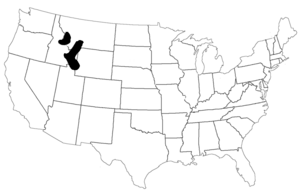Idaho pocket gopher facts for kids
Quick facts for kids Idaho pocket gopher |
|
|---|---|
| Conservation status | |
| Scientific classification | |
 |
|
| Range of the Idaho pocket gopher in the United States |
The Idaho pocket gopher (Thomomys idahoensis) is a small rodent that lives underground. It's part of the Geomyidae family, which includes other gophers. This gopher has a light skull and its fur color can be different from one gopher to another. You can find it in the western United States, living in places like savannas, shrubland, and grasslands. Idaho pocket gophers live alone in their burrows and stay active all year. Scientists are still learning a lot about how they behave and their lives. The International Union for the Conservation of Nature says this species is "least-concern", meaning it's not currently in danger.
Contents
Understanding the Idaho Pocket Gopher's Family Tree
The Idaho pocket gopher was first described by a scientist named Clinton Hart Merriam in 1901. He found the first example of this gopher near Birch Creek in Idaho. The gopher he studied was a male collected in 1890.
This gopher belongs to a group called the Thomomys genus. This group of gophers lives all over western North America. The Thomomys genus is part of a larger family called Geomyidae, which are all types of pocket gophers.
Different Types of Idaho Pocket Gophers
There are three main types, or subspecies, of the Idaho pocket gopher:
- T. i. idahoensis: These gophers can vary a lot in size and color. They are found in eastern Idaho and parts of Montana. The biggest ones live in the Snake River Plain.
- T. i. pygmaeus: This type is small and dark brown. You can find them in southwestern Wyoming, southwestern Idaho, and northern Utah. It's the only subspecies that lives in Utah.
- T. i. confinus: These gophers live in western Montana.
What Does the Idaho Pocket Gopher Look Like?
The Idaho pocket gopher's size, weight, and foot length can vary. They are usually no more than 150 millimeters (about 6 inches) long. They weigh up to 90 grams (about 3 ounces). Their hind feet are typically no longer than 26 millimeters (about 1 inch).
Their fur color on their back can be yellowish-brown with dark tips. It can also be grayish-brown or even dark brown all over. Most have dark gray fur around their nose. Their belly area is light gray, often mixed with yellow or yellowish-brown. Their feet look whitish. The color of their tail can also be different from one gopher to another. In winter, their fur is usually paler than in summer.
The gopher's skull is small and light. Its front teeth, called incisors, are slender and don't stick out much. These gophers have either 56 or 58 chromosomes, which are tiny parts inside their cells that carry genetic information. They also have small ears.
Where the Idaho Pocket Gopher Lives
The Idaho pocket gopher lives in the western United States. You can find them from central Idaho to the southern and western parts of Montana. There's also a separate group living in southwestern Wyoming, southeastern Idaho, and northeastern Utah.
These gophers make their homes in different types of open areas. They live in savannas, which are grasslands with scattered trees. They also live in shrubland, which are areas with many bushes. And they can be found in grassland habitats.
How Idaho Pocket Gophers Live and Behave
Idaho pocket gophers live in burrows they dig underground. Each gopher digs and lives in its own burrow, so they are usually alone. They stay active all year long, even when it's cold. They store the soil they dig up inside their burrows. This soil stays there even after the snow melts.
In some areas, the Idaho pocket gopher lives in the same place as the northern pocket gopher. When two species live in the same area, it's called being sympatric. But even though they live near each other, they do not have babies together. The Idaho pocket gopher likes shallower, rockier soil for its burrows. The northern pocket gopher prefers deeper soil with fewer rocks.
Scientists don't know exactly what the Idaho pocket gopher eats. However, other gopher species that are related to it eat parts of plants. They eat both the parts of plants that are above ground and those below ground. They mostly eat forbs (flowering plants that are not grasses) and grasses.
Reproduction and Life Cycle
Not much is known about the life of the Idaho pocket gopher, including when they breed or how many babies they have at once. It's most likely that they have babies in the spring, after the snow has melted.
Their breeding habits are probably similar to the northern pocket gopher. The northern pocket gopher is pregnant for about 19 to 20 days. It usually gives birth to between four and seven babies. The lifespan of the Idaho pocket gopher is also unknown. However, most pocket gophers usually live for less than two years.
Protecting the Idaho Pocket Gopher
Currently, there are no known Idaho pocket gophers living in protected areas or in zoos. The US state of Montana does protect this species.
The IUCN (International Union for the Conservation of Nature) has listed the Idaho pocket gopher as a species of "least-concern". This means it's not currently facing major threats. It lives in a large area, and its population isn't decreasing quickly enough to be considered more threatened. However, scientists don't know if its population is growing or shrinking overall. The Idaho pocket gopher is also listed in the Utah Wildlife Action Plan. This plan identifies it as a species that greatly needs conservation efforts.


